Stability analysis for yield and its attributing traits in advanced breeding lines of rice (Oryza sativa L.)
Bạn đang xem bản rút gọn của tài liệu. Xem và tải ngay bản đầy đủ của tài liệu tại đây (299.17 KB, 11 trang )
Int.J.Curr.Microbiol.App.Sci (2017) 6(5): 1579-1589
International Journal of Current Microbiology and Applied Sciences
ISSN: 2319-7706 Volume 6 Number 5 (2017) pp. 1579-1589
Journal homepage:
Original Research Article
/>
Stability Analysis for Yield and its Attributing Traits in
Advanced Breeding Lines of Rice (Oryza sativa L.)
K.P. Rashmi, B.M. Dushyanthakumar*, G.K. Nishanth and S. Gangaprasad
Department of Genetics and Plant Breeding, College of Agriculture, UAHS, Shivamogga, India
*Corresponding author:
ABSTRACT
Keywords
Grain yield,
Stability.
Oryza sativa L.
Article Info
Accepted:
17 April 2017
Available Online:
10 May 2017
Twenty-two advanced breeding lines of rice were evaluated for their stability
parameters with respect to yield and its attributing characters like Days to fifty per
cent flowering, plant height (cm), panicle length (cm), number of tillers per plant
and grain yield (kg/ha) in a multi-locational trial at three different sites viz.
ZAHRS, Mudigere, ZAHRS, Bramhavara and College of Agriculture
Shivamogga. Pooled analysis of variance reflects existence of genotype x
environment interactions. Through stability parameter analysis, it was found that
the advanced breeding line JB 15-2 found suitable for all environments. JM 15-4
(Mudigere), JK2 15-7 (Bramhavara) and JK 15-1(Shivamogga) are identified as
suitable lines for specific locations.
Introduction
Rice is the most important staple food in Asia.
More than 90% of the world’s rice is grown
and consumed in Asia, where 60% of the
world’s population lives. Rice accounts for
35-60% of the caloric intake of three billion
Asians (Guyer et al., 1998). Over 150 million
hectares of rice is planted annually, covering
about 10% of the world’s arable land. In
1999/2000, this amounted to some 600
million tonnes of rice seed, equal to 386
million tonnes of milled rice. With the world
population estimated to increase from 6.2
billion in the year 2000 to about 8.2 billion in
the year 2030, the global rice demand will rise
to about 765 million tonnes, or 533 million
tonnes of milled rice (Annon, 2002). The
increasing population rate dictates the world’s
food requirements, especially for rice, so the
extra rice required to feed the accelerating
population ought to be met only by improving
the productivity of rice.
In India, rice is being grown as a major food
crop under diverse agro-climatic conditions. It
is very much necessary to develop varieties
having stable yield performance over diverse
environments. Hence, knowledge on the
nature and magnitude of genotype x
environment interactions is important in
understanding the stability of a particular
variety before it is being recommended for a
given situation. Testing of genotypes under
different
environments
differing
in
unpredictable variation is an accepted
1579
Int.J.Curr.Microbiol.App.Sci (2017) 6(5): 1579-1589
approach for selecting stable genotypes
(Eberhart and Russel, 1966).
Materials and Methods
The present experiment material comprised of
twenty two advanced breeding lines with two
checks developed at department of genetics
and plant breeding, Agriculture college
Shivamogga. The trials were conducted in a
randomized complete block design with two
replications at three locations ZAHRS,
Mudigere. ZAHRS, Bramhavara and College
of
Agriculture
(CoA),
Shivamogga
representing diverse agro climatic conditions
during kharif 2015. Observations were
recorded on five randomly selected plants in
each replication in each environment in
respect of 13 quantitative characters viz.,
Days to fifty per cent flowering, days to
maturity, plant height (cm), panicle length
(cm), number of tillers per plant, number of
productive tillers per plant, number of
spikelets per panicle, number of grains per
panicle, Panicle fertility (per cent), Test
weight (g), grain yield (kg/ha), Straw yield
per hectare (kg/ha) and Harvest index.
Stability analysis was carried out by using the
stability model proposed by Eberhart and
Russell (1966).
Results and Discussion
Pooled analysis of variance showed highly
significant mean sum of squares for
genotypes and environments for all the
characters studied, indicating the presence of
substantial variation among the genotypes
over environments (Table 1). Mean sums of
squares due to varieties found significant for
panicle length. Mean sum of square due
environments found highly significant for all
characters studied except for panicle length
and number of grains per panicle. The
variance due to Genotype X Environment
(Linear) shows no significant for all the traits
except for number of spikelets per panicle,
panicle fertility, test weight and straw yield
indicating the absence of genetic differences
among
varieties
for
regression
on
environmental indices and thus the further
predication of genotypes would be difficult
for these traits. Significant pooled deviation
found significant for all traits except for plant
height (cm), number of tillers per plant and
number of spikelets per panicle suggested that
the performance of different genotypes
fluctuated considerably in respect to their
stability for respective characters. Thus both
predictable and unpredictable components
contributed significantly to differences in
stability among genotypes. These results are
in agreement to those reported by Nayak
(2008) and Shadakshari (2001) in rice.
Environmental index can provide the basis for
identifying the favourable environments for
the expression of maximum potential of the
genotype.
Environmental index provide the basis for
identifying the favourable environments for
the expression of maximum potential of the
genotype. ZAHRS, Mudigere found to be the
most favourable location for days to fifty per
cent flowering, panicle length and test weight
(g) and harvest index. While, COA,
Shivamogga found to be the most favourable
location for number of tillers/plant, number of
productive tillers per plant, number of
spikelets per panicle, number of grains per
panicle grain yield (kg/ha) and straw yield
(kg/ha). ZAHRS, Bramhavara found to be the
most favourable location for days to maturity,
plant height (cm) and panicle fertility (%)
In the present study, stability of 22 rice
advanced breeding lines with respect to 5
characters was judged by three parameters
viz., mean (x), regression coefficient (bi) and
deviation from regression(S2di) using the
model proposed by Eberhart and Russell
(1966). Taking these parameters into
1580
Int.J.Curr.Microbiol.App.Sci (2017) 6(5): 1579-1589
consideration, the results
discussed character wise.
obtained
are
Days to fifty per cent flowering
Among 22 advanced breeding lines JK2 15-2
and JK2 15-3 (Mudigere), JK2 15-5
(Bramhavara) and JK2 15-2 (Shivamogga) are
identified as stable lines for specific locations.
The advanced breeding line JK10 15-1
exhibited mean value (94.83) less than
population mean for days to fifty per cent
maturity, had regression coefficient unity and
least deviation from regression identified as
stable across all the environments (Table 3).
Days to fifty per cent flowering
JK10 15-1 and JK10 15-2 (Mudigere), JK2
15-3
(Bramhavara)
and
JM
15-4
(Shivamogga) are identified as stable lines for
specific locations. The advanced breeding line
JM 15-1, JM 15-2 and JK2 15-7 exhibited less
mean value for days to maturity than
population mean, also had regression
coefficient value around unity and less
deviation from regression is identified as
stable across the environments (Table 3).
Plant height (cm)
Among 22 advanced breeding lines JM 15-2
exhibited more mean value for plant height
than the population mean also had regression
coefficient value is around unity and less
deviation from regression. Hence, it is
identified as stable across the environments.
Whereas, JK10 15-2 (Mudigere), JK2 15-2
(Bramhavara) and JT 15-2 (Shivamogga) are
identified as stable lines for specific locations
(Table 3).
Panicle length (cm)
JT 15-1 (Mudigere), JT 15-1 is (Bramhavara)
and JT 15-3 (Shivamogga) are identified as
stable lines for specific locations. The
advanced breeding line JM 15-4 exhibited
more mean value than the population mean
for panicle length and also had regression
coefficient value is around unity and less
deviation from regression for panicle length is
identified as stable across the environments
(Table 3).
Number of tillers per plant
Among 22 advanced breeding lines JT 15-1
(Mudigere), JK2 15-3 (Bramhavara) and JM
15-1 and JK10 15-2 (Shivamogga) are
identified as stable lines for specific locations.
The advanced breeding lines JM 15-4, JK 152 and JK2 15-1 exhibited more mean value
than the population mean and also had
regression coefficient value is around unity
and less deviation from regression for number
of tillers per plant is identified as stable across
the environments (Table 3).
Number of productive tillers
JT 15-3, JK 15-1 and JK2 15-7 (Mudigere),
JB 15-2 and JK2 15-3 (Bramhavara) and
JK10 15-2 (Shivamogga) are identified as
stable lines for specific locations. The
advanced breeding lines JM 15-4 and JK2 157 exhibited more mean value than the
population mean and also had regression
coefficient value is around unity and less
deviation from regression for number of
productive tillers per plant is identified as
stable across the environments (Table 3).
Number of spikelets per panicle
JK 15-1 (Mudigere), JM 15-5 (Bramhavara)
and JK2 15-1 (Shivamogga) are identified as
stable lines for specific locations. The
advanced breeding lines K10J 15-1 and JK2
15-4 exhibited more mean value than the
population mean and also had regression
coefficient value is around unity and less
1581
Int.J.Curr.Microbiol.App.Sci (2017) 6(5): 1579-1589
deviation from regression for number of
spikelets per panicle across the environments
(Table 3).
Number of grains panicle
JK2 15-1 (Mudigere), JK2 15-1 (Bramhavara)
and JK2 15-1 (Shivamogga) are identified as
stable lines for specific locations. The
advanced breeding line JM 15-3 exhibited
more mean value than the population mean
and also had regression coefficient value is
around unity and less deviation from
regression for number of grains per panicle
across the environments (Table 3).
Table.1 Pooled MSS values for different quantitative traits over three environments
Source of Variations
Rep within Env.
Varieties
Env.+ (Var.*Env.)
Environments
Var.*Env.
Environments(Lin.)
Var.*Env.(Lin.)
Pooled Deviation
Pooled Error
Total
df
3
23
48
2
46
1
23
24
69
71
X1
X2
1.07
2.17
8.12
27.55
53.70**
64.04
1153.60** 957.04**
5.88
25.22
2337.19** 1914.07**
3.92
12.42
7.52**
36.43**
0.84
5.45
38.94
53.22
X3
1.96
1.47*
0.62
0.58
0.62
1.15
0.49
0.72**
0.21
0.89
X4
X55
1.03
124033.52
1.31
332757.80
9.75**
1244740.03
210.17** 12590050.84**
1.04
751465.65
420.34** 25180101.68**
1.04
394179.79
1.00
1062553.35**
0.63
86867.30
7.02
949309.17
Table.2 Environmental indices for yield and yield components in rice
Traits
Days to 50% flowering
Days to maturity
Plant height(cm)
Panicle length(cm)
No. of tillers / plant
No. of productive tillers / plant
No. of spikelets / panicle
No. of grains / panicle
Panicle fertility (%)
Test weight (g)
Grain yield (kg/ha)
Straw yield (kg/ha)
Harvest index
ZAHRS, Mudigere
7.56
0.35
-6.47
0.13
-2.34
-2.24
2.76
-2.05
-3.98
0.15
228.57
-829.16
0.094
1582
Locations
ZAHRS, Bramhavara
-1.49
9.14
6.14
0.03
-0.99
-1.42
-6.23
-0.59
4.26
-0.15
-810.99
-680.04
-0.080
COA, Shivamogga.
-6.07
-9.49
0.82
-0.16
3.33
3.66
3.47
2.64
-0.28
0.01
582.42
1509.19
-0.014
Int.J.Curr.Microbiol.App.Sci (2017) 6(5): 1579-1589
Table.3 Mean performance and stability parameters for days to fifty per cent flowering and plant height (cm) in rice
Triats
Advanced breeding lines
JB 15-1
JB 15-2
JM 15-1
JM 15-2
JM 15-3
JM 15-4
JM 15-5
JT 15-1
JT 15-2
JT 15-3
JK10 15-1
JK10 15-2
K10J 15-1
JK 15-1
JK 15-2
JK2 15-1
JK2 15-2
JK2 15-3
JK2 15-4
JK2 15-5
JK2 15-6
JK2 15-7
Jyothi
KHP 10
Population mean
Days to 50% flowering
Mean
bi
Mean
96.67
0.87
0.36
97.50
1.23
20.17**
99.67
1.31
-0.72
99.50
1.06
2.30
98.67
1.29
3.91*
96.33
1.21
2.81*
97.67
1.10*
-0.85
99.17
0.58
1.79
99.33
0.53
5.69**
96.17
1.17
3.02*
94.83
1.00
1.22
97.33
0.93
0.89
100.16
1.15
17.77**
97.50
1.09
0.38
98.00
0.83
-0.02
94.83
0.93
9.24**
94.66
0.99
34.92**
95.00
0.92
28.83**
96.17
0.77
12.96**
95.83
1.14
14.47**
97.33
1.17
-0.60
99.00
0.94
-0.59
98.00
0.87
1.40
97.33
0.93
0.86
97.31
Days to maturity
bi
bi
S²Di
143.66
0.91**
-1.67
143.83
0.86
1.13
141.50
0.91
-0.97
141.33
0.99
-0.65
143.33
0.88
-0.58
141.66
1.19
11.13**
141.66
0.91**
-1.67
141.83
1.02
0.91
142.33
1.07
-1.54
143.66
1.02
-0.23
142.00
1.01
6.63*
141.00
1.28
1.46
141.00
1.15*
-1.65
141.33
0.93
-1.63
141.66
0.91**
-1.67
142.50
1.04
-1.64
141.66
0.88
-1.33
141.66
0.72
1.34
141.33
0.96
2.50
142.33
1.15
-0.79
142.16
1.12
0.00
140.00
0.96
-0.16
142.00
1.04
-1.64
141.00
0.99
-0.60
141.96
1583
Plant height (cm)
Mean
bi
S²Di
93.16
0.53
-0.41
86.51
1.28
115.32**
93.79
1.47
-3.33
91.72
0.88
1.62
90.20
0.51
9.80
91.91
0.83
-5.18
92.76
0.59
-4.49
92.60
1.52
83.76**
96.16
0.90
286.59**
93.85
0.46*
-5.27
88.13
1.53
-1.75
94.08
0.27
-1.09
95.06
0.81
20.77*
90.00
0.93
9.19
85.48
1.59*
-5.18
88.05
1.36
2.64
91.70
1.30
111.91**
90.60
1.22
35.36**
90.90
1.07
65.3**
84.88
1.39
3.77
92.15
1.32
16.22*
89.40
0.80
0.78
88.13
0.48
-1.25
87.43
0.86
11.73
90.77
Int.J.Curr.Microbiol.App.Sci (2017) 6(5): 1579-1589
Triats
Advanced breeding lines
JB 15-1
JB 15-2
JM 15-1
JM 15-2
JM 15-3
JM 15-4
JM 15-5
JT 15-1
JT 15-2
JT 15-3
JK10 15-1
JK10 15-2
K10J 15-1
JK 15-1
JK 15-2
JK2 15-1
JK2 15-2
JK2 15-3
JK2 15-4
JK2 15-5
JK2 15-6
JK2 15-7
Jyothi
KHP 10
Population mean
Panicle length
Mean
19.52
19.38
20.32
19.97
19.24
20.28
20.25
21.80
20.83
20.41
19.38
20.09
19.40
20.41
19.38
19.27
19.79
21.12
20.46
20.66
19.93
20.33
18.74
19.45
20.02
bi
5.23
-0.23
7.00
1.85
-0.54
0.82
0.64
4.65
2.29
-2.48
-4.27
-2.12
0.00
1.71
5.02
-2.17
3.17
6.81
3.32
-3.24
-1.62
0.06
1.15
-2.96
Number of tillers per plant
S²Di
-0.26
0.13
0.85
0.21
-0.18
-0.25
3.86**
-0.10
-0.14
3.40**
2.01**
0.02
-0.26
-0.05
-0.20
0.54
0.88*
-0.28
0.92*
-0.10
-0.24
-0.20
-0.29
0.03
Mean
8.50
9.33
9.33
8.67
8.67
8.83
8.17
10.33
8.50
8.50
9.67
9.00
9.00
8.67
9.00
9.50
8.67
9.83
8.17
8.67
8.50
8.67
7.67
7.33
8.79
1584
bi
1.14
0.88
1.49
0.95
0.74
0.84
0.87
1.12
0.77
0.86
0.98
1.59
1.06
1.24
1.09
1.09
1.40
1.04
0.70*
0.78
1.02
0.95
0.67
0.76
S²Di
0.61
1.09
0.58
0.23
-0.12
-0.25
-0.59
-0.52
-0.53
0.06
4.66**
0.79
-0.64
0.83
-0.10
-0.10
0.38
1.67
-0.64
1.35
-0.24
0.23
-0.22
-0.08
Number of productive tillers per
plant
Mean
bi
S²Di
7.67
1.18*
-0.58
8.83
0.78
2.27*
8.00
1.20
0.52
7.67
0.90
-0.31
8.00
0.74
3.68**
8.17
0.92
-0.55
7.00
0.93
0.22
8.50
1.12
0.03
7.33
0.84
0.13
7.67
0.88
0.91
8.17
0.98
4.64**
8.00
1.51
-0.55
7.33
1.27*
-0.58
7.50
1.16
5.44**
8.00
1.12
0.03
8.17
1.21
-0.05
7.67
1.41
1.76*
9.00
1.01
3.06*
7.00
0.81
-0.37
7.50
0.83
-0.53
7.33
0.99
-0.26
8.00
0.93
0.22
7.17
0.63
-0.45
7.00
0.68*
-0.58
7.77
Int.J.Curr.Microbiol.App.Sci (2017) 6(5): 1579-1589
Triats
Advanced breeding lines
JB 15-1
JB 15-2
JM 15-1
JM 15-2
JM 15-3
JM 15-4
JM 15-5
JT 15-1
JT 15-2
JT 15-3
JK10 15-1
JK10 15-2
K10J 15-1
JK 15-1
JK 15-2
JK2 15-1
JK2 15-2
JK2 15-3
JK2 15-4
JK2 15-5
JK2 15-6
JK2 15-7
Jyothi
KHP 10
Population mean
Number of spikelets per
panicle
Mean
bi
S²Di
83.86
0.32
-74.68
100.00
0.89
-84.51
87.50
2.43
-45.93
98.33
-0.05
-47.61
92.66
0.99
-88.30
113.66
4.53
170.47
119.50
-0.01
-33.14
96.00
-0.18
-42.06
100.17
0.84
-84.40
106.83
2.25
66.76
112.33
1.26
-88.44
83.33
1.02
-88.58
113.50
0.82
-78.84
101.33
2.74
317.57*
94.16
0.69
-3.85
142.83
3.89
28.24
117.33
8.58
414.74*
107.33
0.41
-66.03
108.33
0.87
-82.88
109.67
0.77
-78.67
119.83
0.34
-54.39
100.33
2.09
-67.49
97.50
-0.09
-85.66
102.83
-1.88
42.54
104.67
Panicle fertility (%)
Number of grains per panicle
Mean
66.17
77.67
61.83
76.17
71.17
79.67
95.83
76.83
78.67
82.17
79.33
55.50
98.17
72.83
73.00
118.33
95.50
85.33
83.50
87.67
102.17
82.00
72.00
76.67
81.17
1585
bi
1.26
1.91
0.54
1.91
0.94
0.26
1.59*
1.82
1.46
-0.12
2.64
1.59
1.11
3.09
2.11
0.16
-2.11
2.40
1.24
1.60
1.55
-0.03
-0.67
-2.25
S²Di
-47.10
-4.18
-25.66
-4.18
-49.07
62.88
-50.99
-7.87
-46.48
165.48*
183.86*
-4.54
-19.03
350.63*
55.80
313.85*
1434.30**
64.78
-50.07
-48.43
-50.12
157.47*
-1.60*
175.51
Mean
79.03
75.63
72.05
77.00
77.83
73.05
80.15
79.95
78.87
77.13
71.65
67.27
86.57
71.42
77.40
83.22
81.93
79.93
77.18
79.67
84.98
81.55
72.22
73.13
77.45
bi
0.69
2.03*
1.77
0.89
0.71
2.40
-0.26**
0.82
1.14
-0.18**
3.48*
2.69*
-0.18*
0.42
0.88
0.94
0.34*
1.99
0.59*
0.81
-0.11**
-0.27**
0.83
1.60
S²Di
-20.70
-20.53
-20.26
-20.50
-20.72
-18.24
-20.73
-20.66
-20.68
-20.74
-20.35
-20.66
-20.70
-20.43
-20.51
-20.72
-20.65
-20.34
-20.71
-20.55
-20.74
-20.73
-20.34
-14.16
Int.J.Curr.Microbiol.App.Sci (2017) 6(5): 1579-1589
Triats
Advanced breeding lines
JB 15-1
JB 15-2
JM 15-1
JM 15-2
JM 15-3
JM 15-4
JM 15-5
JT 15-1
JT 15-2
JT 15-3
JK10 15-1
JK10 15-2
K10J 15-1
JK 15-1
JK 15-2
JK2 15-1
JK2 15-2
JK2 15-3
JK2 15-4
JK2 15-5
JK2 15-6
JK2 15-7
Jyothi
KHP 10
Population mean
Mean
19.70
20.32
19.85
20.37
19.25
20.70
20.08
21.80
20.57
20.92
20.42
21.48
19.57
21.23
20.03
20.23
19.38
20.43
20.63
21.57
21.07
20.75
19.60
19.80
20.40
Test weight (g)
bi
5.91**
2.30
5.59**
0.98
-1.31**
0.33**
1.15
1.97
-3.62*
-7.56**
2.62
2.13
-1.32*
3.45*
10.02*
3.78*
-2.80**
0.16
0.16
0.99
3.28
-3.94*
-0.60
2.31
1586
S²di
-0.28
-0.27
-0.28
-0.27
-0.28
-0.28
-0.28
-0.28
-0.28
-0.28
-0.27
-0.28
-0.28
-0.28
-0.27
-0.27
-0.28
-0.28
-0.28
-0.28
-0.27
-0.28
-0.03
-0.26
Mean
3786.00
4692.50
3832.67
3829.83
3508.83
4280.50
3697.17
3900.67
3607.33
4041.67
3638.83
3600.33
4025.00
4679.83
3987.67
3942.17
4403.83
3859.83
3688.33
3726.00
3823.83
3642.67
3557.50
3513.33
3886.09
Grain yield (kg/ha)
S²di
bi
0.91
-46573.68
1.06
296378.44
0.38
382825.53*
0.71
-34081.83
0.63
1430848.39**
1.08
3270262.40**
0.89
527148.99*
1.28
383601.74*
1.10
906149.80**
0.83
637119.74**
1.13
348622.68*
0.40
56758.48
1.18
4230798.51**
2.25
1281283.14**
1.93
980228.46**
1.50
1208098.07**
1.68
2134375.21**
0.89
3308326.15**
0.50
540584.24**
0.49
164093.75
0.43
273077.44*
-0.11
1255149.52**
0.43
-675222.87
0.64*
175.51
Int.J.Curr.Microbiol.App.Sci (2017) 6(5): 1579-1589
Triats
Advanced breeding lines
JB 15-1
JB 15-2
JM 15-1
JM 15-2
JM 15-3
JM 15-4
JM 15-5
JT 15-1
JT 15-2
JT 15-3
JK10 15-1
JK10 15-2
K10J 15-1
JK 15-1
JK 15-2
JK2 15-1
JK2 15-2
JK2 15-3
JK2 15-4
JK2 15-5
JK2 15-6
JK2 15-7
Jyothi
KHP 10
Population mean
Mean
7565.50
8162.67
7947.67
8335.50
7005.50
8577.67
7702.33
7764.67
6998.67
7868.50
6848.67
6410.83
7261.33
8190.83
6821.33
7720.67
9288.50
7942.83
6731.50
6726.00
8000.17
6744.83
7313.33
7773.83
7571.01
Straw yield (kg/ha)
S²di
bi
2.06
-38452.60
2.17
1560122.35*
0.87
-253661.53
0.91
-402746.37
0.44
-185273.94
0.02
-302120.62
0.30
-429291.09
1.27
479806.51
0.36
-2460.31
0.79
-166870.59
0.73
767777.66
0.08
-393397.71
-0.77
2540273.94*
2.72*
-4551157.06
1.11
-118931.85
1.93
-159997.15
1.96
-95423.35
2.06
4809571.59**
1.08
893184.45
0.18
-334612.64
1.53
-348548.77
0.73
5310360.37**
0.76
710940.52
0.71
2350437.11*
1587
Mean
0.535
0.550
0.507
0.465
0.533
0.515
0.487
0.505
0.508
0.520
0.542
0.567
0.547
0.612
0.583
0.520
0.473
0.493
0.547
0.573
0.495
0.565
0.500
0.452
0.525
Harvest index
bi
1.551
1.267
1.385
0.982
1.369
1.680
1.416*
1.319
1.412*
1.297
1.020
1.028
1.426
1.397
1.327
0.949
0.594
0.692
0.688
0.419
0.601
0.744
-0.188
-0.374
S²di
0.007*
-0.001
0.004
-0.001
-0.002
0.001
-0.002
0.003
-0.001
0.004
-0.002
-0.002
0.002
0.000
0.022**
-0.001
0.002
-0.001
-0.002
0.006
-0.002
-0.001
0.003
-0.001
Int.J.Curr.Microbiol.App.Sci (2017) 6(5): 1579-1589
Panicle fertility (per cent)
Straw yield (kg/ha)
K10J
15-1
(Mudigere),
JK2
15-3
(Bramhavara) and K10J 15-1 (Shivamogga)
are identified as stable lines for specific
locations. The advanced breeding lines JB 151, JT 15-1, JK2 15-1 and JK2 15-5 exhibited
more mean value than the population mean
and also had regression coefficient value is
around unity and less deviation from
regression for panicle fertility across the
environments (Table 3).
K10J
15-1
(Mudigere),
JK2
15-2
(Bramhavara) and JK 15-1 (Shivamogga) are
identified as stable lines for specific locations.
The advanced breeding lines JM 15-1, JM 152 and JT 15-3 exhibited more mean value
than the population mean, regression
coefficient value is around unity and less
deviation from regression for straw yield
across the environments (Table 3).
Harvest Index
Test weight (g)
JT 15-1 (Mudigere), JT 15-3 (Bramhavara)
and JT 15-1 (Shivamogga) are identified as
stable lines for specific locations. The
advanced breeding line JK2 15-5 exhibited
more mean value than the population mean,
regression coefficient value is around unity
and less deviation from regression for test
weight across the environments.
Grain yield (kg/ha)
Among 22 advanced breeding lines including
checks only seven advanced breeding lines
had significant deviation from regression for
grain yield per hectare, which means
remaining advanced breeding lines are
unstable. The advanced breeding line JB 15-2
had more mean value than population mean
also had regression coefficient value is around
unity and less deviation from regression. So it
is indicated that this advanced breeding line
had
stable
performance
across
the
environments and less sensitive to
environment it can adapt to the diverse
environments. Hence, it can be used as stable
line adopted across the environments and may
be proposed for farm trials. JM 15-4
(Mudigere), JK2 15-7 (Bramhavara) and JK
15-1(Shivamogga) are identified as suitable
lines for specific locations (Table 3).
JK 15-1 (Mudigere), Jyothi (Bramhavara) and
JK 15-2 (Shivamogga) are identified as stable
lines for specific locations. The advanced
breeding lines JK2 15-4 and JK2 15-7
exhibited more mean value than the
population mean and also had regression
coefficient value is around unity and less
deviation from regression for harvest index
across the environments (Table 3).
In conclusion, the present study provided an
evaluation of genotypic and environmental
performance of 22 advanced breeding lines of
rice over varied environments. Stability
analysis demonstrated that advanced breeding
line JB 15-2 is less responsive to changed
environmental conditions and can be grown
over a range of environments in terms of
yield.
References
Anonymous. 2002. FAO, Concern about rice
production pratices (FAO).
Eberhart, S.A. and Russell, W.A. 1966.
Stability parameters for comparing
varieties. Crop Sci., 6(1): 36-40.
Guyer, D., Tuttle, A., Rouse, S., Volrath, S.,
Johnson, M., Potter, S., Gorlach, J.,
Goff, S., Crossland, L., and Ward, E.,
1998, Activation of latent transgenes in
arabidopsis using a hybrid transcription
factor. Genet., 149: 633-639.
1588
Int.J.Curr.Microbiol.App.Sci (2017) 6(5): 1579-1589
Nayak, A.R. 2008. Stability of quality
characters in scented rice. Ind. J. Agric.
Res., 24(2): 102-106.
Shadakshari, Y.G., Chandrappa, H.M.,
Kulkarni, R.S. and Shashidher, H.E.
2001. Genotypic X Environment
interaction in low land rice genotypes of
hill zone of Karnataka. Ind. J. Genet.,
64(4): 350-352.
How to cite this article:
Rashmi, K.P., B.M. Dushyanthakumar, G.K. Nishanth and Gangaprasad, S. 2017. Stability
Analysis for Yield and its Attributing Traits in Advanced Breeding Lines of Rice (Oryza sativa
L.). Int.J.Curr.Microbiol.App.Sci. 6(5): 1579-1589.
doi: />
1589

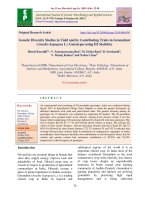
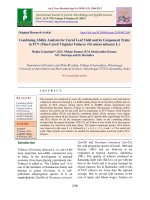
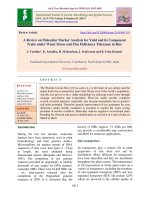
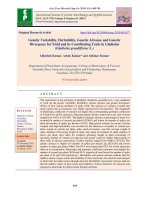
![Genetic variability studies in F2 segregating populations for yield and its component traits in Okra [Abelmoschu sesculentus (L.)Moench]](https://media.store123doc.com/images/document/2020_01/13/medium_nxs1578931693.jpg)

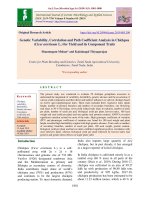

![Studies on combining ability for yield and its component traits in rabi sorghum [Sorghum bicolor (L.) Moench]](https://media.store123doc.com/images/document/2020_03/02/medium_mzw1583124925.jpg)